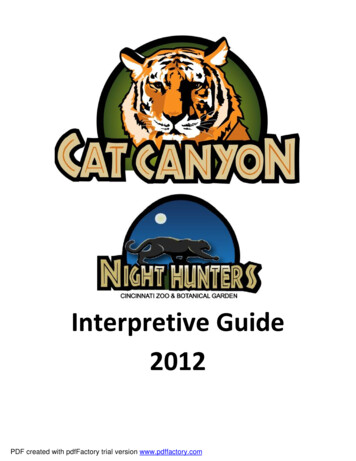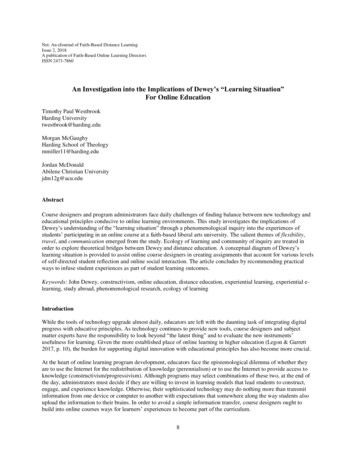
Transcription
Interpretive Guide2012PDF created with pdfFactory trial version www.pdffactory.com
Cat Canyon/Night Hunters Interpretive GuideTable of ContentsExhibit Summary3Theme & Sub-themes4Featured Species4Visitor JourneyNight HuntersCougarTigerSnow leopard5726Resources28Cincinnati Zoo & Botanical Garden, 2012PDF created with pdfFactory trial version www.pdffactory.com2
Cat Canyon/Night Hunters Interpretive GuideExhibit SummaryTwigs snap. Leaves rustle. You get a prickly feeling onthe back of your neck as you wonder whether someone,or something, is watching you, stalking you, huntingyou. It’s an eat-or-be-eaten world and, in the CincinnatiZoo’s Cat Canyon exhibit, you are the prey.upgraded ventilation system, the entire public viewingarea was redone. The carpet is gone, the walls arerepaired and repainted, and the traditional strollthrough an exhibit building has been transformed intomulti-sensory journey through the wild at night.Cat Canyon encompasses and links up the Night Huntersexperience (which opened in May 2011) with theformer Tiger Canyon area and includes new exhibits forcougars, tigers, and snow leopards. Cat Canyon providesan exciting, sensory adventure into the world of ourgreat predators, the wild cats, while strengthening theZoo’s commitment to the conservation of threatenedspecies through education and scientific research in thewild and at the Zoo.Along the way, guests can watch fishing cats scoop fishout of the water, sand cats on the prowl, and more ontheir smart phones using a Quick Response (QR) codereader application.A rushing waterfall greets you as you begin your trekalong the wooded Cat Canyon trail. You first come uponthe Night Hunters building; enter to journey throughthe wild at night and discover nocturnal predators, ifyou dare. Night Hunters features a variety of small catsas well as other nocturnal predators such as theEurasian eagle owl, vampire bat, and Burmese python.It’s dark. A chorus of crickets sings. A breeze carries inthe scent of damp earth. You pass under a tree and geta prickly feeling on the back of your neck. What’s thatsound? Did that bush just move? You feel a rush ofwind. Out of the corner of your eye, you catch a glimpseof an owl flying by. You cautiously pass by a roost ofvampire bats and an ocelot on patrol. Adrenalinecourses through your veins, preparing your body tofight or take flight in the face of danger. You make outthe silhouette of a clouded leopard. Its shining yelloweyes follow you as you sneak by.Originally built in 1950, the Carnivora House wasrenovated and transformed into the award-winning CatHouse in 1985. Once again the Zoo has revitalized thisexhibit building. In addition to a new roof and anThe journeyculminates inan openinteractivearea. Hereguests canmeet azookeeperand witness the fishing cat’s supreme aquatic huntingskills as it dives after minnows. Interactive computerkiosks invite visitors to participate in the Saving SpeciesWild Cat Campaign (funded by the National ScienceFoundation). Choosing from a selection of images andtext, guests create a digital identification sign forseveral cat species that will be displayed on a rotationalbasis at those species’ exhibits. They have the option toemail their creations to friends and family andencourage them to participate in wild cat conservation,too.As you exit Night Hunters and step back into the light ofday, you may feel a sense of relief and safety. Neverforget, however, that a whole new cast of charactershunts by day.Look up as you approach the glass-fronted cougarexhibit and you may see America’s great cat peeringdown at you from the rocks above. During an AnimalEncounter, watch as the two brothers, Joseph andCincinnati Zoo & Botanical Garden, 2012PDF created with pdfFactory trial version www.pdffactory.com3
Cat Canyon/Night Hunters Interpretive GuideTecumseh, show off their powerful jumping skills. Comeface to face and hand to paw with these impressivepredators as they sidle up to the glass.Continue along the path, through the mist, and aroundthe bend to enter the realm of the tiger. Several openair and glass-fronted viewing opportunities of the newtiger enclosures provide different perspectives fromabove and on ground level. Keep your eyes and earstrained for tiger clues as you make your way toward themain viewing shelter. Watch the tigers patrol theirterritory or take a relaxing soak in their pool. Learnabout the important role of the tiger as a large predatorin nature and the conservation efforts the Zoo supportsto save Malayan tigers in the wild.The last stop along the Cat Canyon trail is a brand new,outdoor exhibit where the snow leopard roams.Perhaps lounging on a rocky ledge, don’t let the snowleopard fool you. It quite easily and expertly climbs andnavigates the mountainside.As you complete your journey through Cat Canyon, youcan breathe a little easier knowing that you survived.How do we ensure that wild tigers and other predatorsalso survive?Cincinnati Zoo & Botanical Garden, 2012PDF created with pdfFactory trial version www.pdffactory.com4
Cat Canyon/Night Hunters Interpretive GuideThemeFeatured SpeciesIt’s an “eat or be eaten” world in the wild.In sequential order:Sub-themes1) Predators are specially designed to hunt and eatother animals (prey).2) Prey must always be aware of theirsurroundings to keep from being eaten.3) Wild cats are the ultimate in predator design.4) At night, predator and prey rely on enhancedsenses and particular strategies.5) An ecosystem would not survive without itspredators, and vice versa.Eurasian eagle owl, Bubo buboPallas’ cat, Otocolobus manulFossa, Cryptoprocta feroxAardwolf, Proteles cristatusClouded leopard, Neofelis nebulosaPygmy slow loris, Nycticebus pygmaeusAardvark, Orycteropus aferPotto, Perodictus pottoGreater bushbaby (Garnett’s galago), Otolemur garnettiiGiant fruit bat (Indian flying fox), Pteropus giganteusVampire bat, Desmodus rotundusSouthern Brazilian ocelot, Leopardus pardalis mitisBurmese python, Python molurusBlack-footed cat, Felis nigripesSand cat, Felis margaritaBobcat, Lynx rufusFishing cat, Prionailurus viverrinusBat-eared fox, Otocyon megalotisFennec fox, Vulpes zerdaCaracal, Caracal caracalBearcat, Arctictis binturongTayra, Eira barbaraCougar, Puma concolorTiger, Panthera tigrisMalayan tiger, Panthera tigris jacksoniSnow leopard, Panthera uncia(subject to change)Cincinnati Zoo & Botanical Garden, 2012PDF created with pdfFactory trial version www.pdffactory.com5
Cat Canyon/Night Hunters Interpretive GuideVisitor JourneyVisitors encounter the entry path off of the main Zoopath across from the Gorilla World exit. A montanelandscape including evergreens, rocky areas, and awaterfall draw visitors’ attention and beckon them toenter. Leaves and grasses rustle. The landscape isintended to heighten the visitors’ sense of awareness.Perhaps they feel as if they are being watched by someunseen predator.Two interpretive signs along the path introduce visitorsto the main themes of the exhibit as well as to thepoetic format of the content they will encounter on thesignage throughout.Cincinnati Zoo & Botanical Garden, 2012PDF created with pdfFactory trial version www.pdffactory.com6
Cat Canyon/Night Hunters Interpretive GuideAs visitors walk beneath a wooden trellis leading themto the Night Hunters building entrance, smallinterpretive signs set up the experience. It’s gettingdark. Shhh! Did you hear that?Night HuntersEntering the Night Hunters building, visitors step into atemperate forest at twilight. A poem greets them andwelcomes them into the night:Cincinnati Zoo & Botanical Garden, 2012PDF created with pdfFactory trial version www.pdffactory.comDARK sky,Smiling MOON.SHADOWS danceTo a CRICKET tune.PAUSE. Listen.Widen your EYES.NIGHT’S aliveWith wild SURPRISE.7
Cat Canyon/Night Hunters Interpretive GuideEurasian Eagle OwlCrickets sing and the occasional owl calls. The scent ofpine lingers and fireflies twinkle. Surrounded by threedimensional fabricated trees with leafy branches rustlingin the breeze, visitors peer into a new Eurasian eagle owlexhibit and catch the flash of an owl flying by on a digitalmonitor screen.With wings that can span up to six feet, the Eurasianeagle owl is one of the largest owls in the world. Itspowerful yet silent wings enable this night hunter tostealthily swoop down and scoop up prey. It can evencatch other birds in mid-air.With two tufts of feathers on its head, presumably usedfor communication, the Eurasian eagle owl looks muchlike its North American relative, the great horned owl.Pallas’ CatRounding the corner, visitors encounter the Pallas’ catexhibit. Among the cricket chorus, a Pallas’ cat call canbe heard every so often.Specialized to live in the mountainous regions ofcentral Asia, the Pallas’ cat’s thick coat of shaggy furand long, bushy tail combat extreme temperatures aslow as -60 F. Its preferred prey is the pika, a smallrabbit-like rodent. It also hunts marmots, hares,gerbils, other small mammals, and the occasional bird.The Pallas’ cat is an expert ambush predator. Once itspots a prey animal, the cat creeps up slowly, maskingits approach by hiding behind whatever vegetativecover is available. A flat forehead and low ears allowthe cat to peek over bushes and rocks withoutexposing much of itself to the unwary prey. At just theright moment, the cat pounces.Cincinnati Zoo & Botanical Garden, 2012PDF created with pdfFactory trial version www.pdffactory.com8
Cat Canyon/Night Hunters Interpretive GuideFossaNext comes the fossa exhibit. Rockwork extends out intothe public space to blur the distinction between thevisitors and the animal. Night sounds of Madagascaraccompany the usual cricket chorus, includingvocalizations of the fossa, lemurs, and a nightjar.The fossa is the largest carnivore on Madagascar. With acatlike appearance, expert climbing and leaping skills,and an affinity for stalking and pouncing on prey, thefossa was once thought to belong to the cat family. Thismongoose relative plays an important role as predatorin keeping prey populations in check.Whooo lives here?Rounding another corner, visitors are invited to peek inside several fabricated tree holes to find out who lives there.Small digital screens play video of a barn owl, honeybee colony, and bushbaby inside.Cincinnati Zoo & Botanical Garden, 2012PDF created with pdfFactory trial version www.pdffactory.com9
Cat Canyon/Night Hunters Interpretive GuideAardwolfVisitors turn their attention now to the right hand sideof the hallway where they first encounter an aardwolfexhibit. Night noises specific to this area include calls ofthe barn owl, black-backed jackal, spotted hyena, andaardwolf.A solitary and nocturnal member of the hyena family,the aardwolf specializes in feeding on termites. Ratherthan digging into a termite nest, the aardwolf simplylicks up the insects with its long tongue and chompsdown on them with its peg-like molars. A singleaardwolf can consume 200,000 termites in one night.Clouded LeopardMoving on, visitors are once again surrounded byfabricated trees with leafy branches hanging overheadas they come upon the clouded leopard exhibit.Looking closely at the stamped concrete beneath theirfeet, the predator’s paw prints indicate that it recentlywalked through this area of the rainforest. Visitorshear calls of the clouded leopard, tokay gecko, andgibbons.A powerful and robust build, short legs, large feet, anda long tail allow the clouded leopard to expertlynavigate the forest canopy. It is able to climb downtree trunks headfirst, travel across horizontal brancheswhile hanging beneath them, and hang from brancheswith its hind feet. The clouded leopard has the longestcanines relative to body size of any cat, enabling it tocatch relatively large prey.Cincinnati Zoo & Botanical Garden, 2012PDF created with pdfFactory trial version www.pdffactory.com10
Cat Canyon/Night Hunters Interpretive GuidePygmy Slow LorisSeparated by glass from the clouded leopard is apygmy slow loris exhibit. While the loris is a potentialprey item for the clouded leopard in the wild, it is alsoa predator in its own right.A nocturnal and arboreal primate, the pygmy slow lorishas large eyes to increase its night vision and graspingdigits to clutch tree branches.The solitary, female loris usually bears one young at atime. The infant clings to its mother’s belly for a fewdays. Soon, the mother will leave the young onebehind, a behavior called “parking,” as she heads out atnight to forage. The young loris relies on camouflageand toxic secretions as defense against predators.Across the hall is a poem that carries the visitor deeper into the night:COOL breeze,Rustling LEAVES.MIDNIGHT bloom.Eyes GLOWING,TIPTOEING.Sunrise SOON?Cincinnati Zoo & Botanical Garden, 2012PDF created with pdfFactory trial version www.pdffactory.com11
Cat Canyon/Night Hunters Interpretive GuideVampire BatTo the right of the poem, is the new vampire bat exhibit.The first section is designed as a cave roost. A rock wallseparates the roost from the main woodland section ofthe exhibit. The bats can fly between the two sectionsthrough small openings in the rock wall. A fabricatedtree extends out of the woodland exhibit into the publicarea. Sounds of the vampire bat, kinkajou, red howlermonkey, and jaguar can be heard.It is a common misconception that vampire bats suckblood. They actually cut a tiny slit in an animal’s skinwith their razor-sharp front teeth and lap up the blood.Chemicals in the bat’s saliva prevent clotting so theblood flows freely until it has had its fill, which isgenerally less than an ounce. Vampire bats rarely attackhumans, preferring to feed on livestock and wildmammals such as tapirs and deer.Visitors can use their smart phones to scan this QR codeto learn how they can help save our local bats. The codelinks visitors to the Save Lucy Campaign web site(www.savelucythebat.org) , which focuses on protectinglocal bats from white nose syndrome.Visitors can use their smart phones to scan this QR codeand learn more about vampire bats.Cincinnati Zoo & Botanical Garden, 2012PDF created with pdfFactory trial version www.pdffactory.com12
Cat Canyon/Night Hunters Interpretive GuidePottoBack across the hall is a potto exhibit. Primates aregenerally categorized into three groupings—monkeys,apes, and prosimians. Typically thought to be moreprimitive than other primates, prosimians tend to besmall and nocturnal. The big-eyed potto certainly fits thebill. Using clamp-shaped hands and feet, with opposablethumbs and big toes, the potto climbs slowly andcarefully through the rainforest canopy, and rarelycomes down from the trees. Though the potto is slow, itcan quickly snatch up small prey animals when theopportunity arises.Visitors can use their smartphones to scan this QR code towatch a baby potto explore itsnew world.AardvarkA multi-species exhibit, featuring the aardvark, greaterbushbaby, and giant fruit bat comes next. Thesoundtrack includes the calls of a bushbaby, westerntree hyrax, and lion. Visitors step into an aardvark denfor a unique viewing opportunity at the last viewingwindow.The aardvark is specialized to eat ants and termites.Sweeping its snout from side to side along the ground,the aardvark sniffs out an insect nest. It digs in with itsshovel-shaped claws, and licks up the ants and termiteswith its long, sticky tongue. One aardvark eats more than50,000 insects a night!Visitors can use their smart phones toscan this QR code to learn aboutPadmae, our aardvark ambassador.Cincinnati Zoo & Botanical Garden, 2012PDF created with pdfFactory trial version www.pdffactory.com13
Cat Canyon/Night Hunters Interpretive GuideGreater Bushbaby (Garnett’s Galago)The greater bushbaby spends the day resting in a treehole or among the vines, hiding from snakes. Itemerges at night to run, climb, and leap—more thansix feet at a time—about the treetops. Large, lightsensitive eyes help the galago know where it's going.It’s called the greater bushbaby because its territorialcall sounds like a child's cry.Visitors can use their smart phones to scan this QRcode to peek at a baby bushbaby.Giant Fruit Bat (Flying Fox)The giant fruit bat roosts in large colonies, up to 1,000individuals, during the day. Just after sunset, it headsout to forage for ripe fruits such as figs and mangosand blooming flowers. It relies on its keen sense ofsmell for locating food. As the bat feeds and fliesthroughout the forest, it pollinates and dispersesseeds, helping to regenerate plant growth in theecosystem.Visitors can use their smart phones to scan this QRcode to learn about the giant fruit bat.Cincinnati Zoo & Botanical Garden, 2012PDF created with pdfFactory trial version www.pdffactory.com14
Cat Canyon/Night Hunters Interpretive GuideSouthern Brazilian OcelotJust beyond the aardvark den, visitors come upon theSouthern Brazilian ocelot exhibit. Here the Mayanruins carry through into the public viewing area alongwith fabricated trees with leafy branches. Visitors cansee animal tracks in the ground and hear the soundsof a South American rainforest at night, including anocelot, agouti, spectacled owl, common pootoo, and apoison dart frog.Here is the first of four flat screens on which visitorcreated digital species ID signs are displayed on arotational basis. Visitors are encouraged to createthese signs as part of the Saving Species Wild CatCampaign at the interactive computer kiosks theyencounter later in the rotunda area.Decorated with dark splotches and stripes, theocelot’s golden coat blends in with patches of lightthat break through the forest canopy. With eyesightsix times better than ours, the ocelot has no troublespotting prey as it patrols the forest floor at night. Theocelot requires habitat that supports a plentiful preypopulation and provides cover from which to huntprey. Unfortunately, suitable habitat is disappearingand being divided into small patches. Mortality onroads that cut through habitat also poses a majorthreat to ocelots. Creating safe corridors betweenpatches of habitat will be essential to a future in thewild for the ocelot.Cincinnati Zoo & Botanical Garden, 2012PDF created with pdfFactory trial version www.pdffactory.com15
Cat Canyon/Night Hunters Interpretive GuideBurmese PythonAcross from the ocelot on the other side of the hall,there is a new Burmese python exhibit that includes apool.One of the largest snakes on Earth, the Burmesepython seeks out prey through scent and heatdetection. It grabs prey in its jaws, coils its bodyaround the victim, and tightens its grip until the preysuffocates. Stretching its mouth open wide, thepython swallows its prey whole.The Burmese python spends a good deal of time inthe water and can stay submerged up to 30 minutesat a time.Black-footed CatNext is the black-footed cat exhibit, which features avisitor-created digital ID sign.One of the smallest wild cats, the black-footed catrests during the day among the bushes or in a burrowabandoned by an aardvark or porcupine. Nocturnal,small, shy, and vulnerable, black-footed cats are rarelyseen in the wild. It emerges at night to stealthily stalkits prey under the cover of darkness, flattening itself tothe ground and taking advantage of any hiding placesalong the way.Cincinnati Zoo & Botanical Garden, 2012PDF created with pdfFactory trial version www.pdffactory.com16
Cat Canyon/Night Hunters Interpretive GuideSand CatThe last species exhibited prior to the transition intothe interactive rotunda area is the sand cat, whichalso features a visitor-created digital ID sign.The sand cat is equipped for desert life. Large earsradiate heat. Covered with hair, its footpads areinsulated from the hot sand. During extreme heat, thesand cat cools off in a burrow. The sand cat does notneed to drink often as it gets enough moisture fromits prey. When threatened, the sand cat relies on itstan coat to blend in with the desert landscape.Cincinnati Zoo & Botanical Garden, 2012PDF created with pdfFactory trial version www.pdffactory.com17
Cat Canyon/Night Hunters Interpretive GuideSaving Species Wild Cat Campaign WallBefore entering the rotunda, visitors encounter theSaving Species Wild Cat Campaign wall. A photo collagedisplays images of a variety of cat species. Four flatscreens are tucked into the collage to provide a dynamiccomponent whereby short video clips, poems, quotes,and other content are displayed. The message is thatwild cats, even the small ones, play a vital role in natureand that the Zoo is working to protect them.Conservation programs for the five small cat species theZoo works with in particular are highlighted.The Cincinnati Zoo & Botanical Garden is one of theworld’s leaders in small cat conservation through ourresearch efforts at CREW, breeding programs in the CatHouse, education initiatives with small felids, andfinancial support for in situ projects. Read about someof the Zoo’s ongoing efforts to broaden basicknowledge of small cat biology, connect captive andwild cat populations, and conserve these imperiledsmall felids in their natural environment.Southern Brazilian Ocelot ConservationA Brazilian ocelot population is being established inAZA-accredited institutions to be cooperativelymanaged in combination with captive ocelotsmaintained in Brazilian zoos. To help achieve this goal,CREW scientists develop innovative reproductivestrategies involving artificial insemination, in vitrofertilization, sperm and embryo cryopreservation, andembryo transfer. We have successfully applied thesereproductive tools to produce healthy offspring fromfounder animals housed in Brazilian zoos whileimproving the genetic management of Brazilian ocelotscurrently maintained in U.S. zoos.The Brazilian Ocelot Consortium (BOC), a partnershipinvolving the Ocelot Species Survival Plan (SSP), ten U.S.zoos (including the Cincinnati Zoo & Botanical Garden),and a Brazilian non-governmental conservationorganization, the Associação Mata Ciliar, works toprovide professional training to Brazilian colleagues,improve captive breeding of Brazilian ocelots, educatethe local populace about ocelots, and restore degradedocelot habitat adjacent to a large nature reserve.Visitors can use their smart phones to scan this codeand learn more about how the Zoo is saving ocelots.Cincinnati Zoo & Botanical Garden, 2012PDF created with pdfFactory trial version www.pdffactory.com18
Cat Canyon/Night Hunters Interpretive GuidePallas’ Cat ConservationResearch at CREW and the National Zoological Parkestablished that Pallas’ cats have a pronouncedreproductive seasonality controlled by light exposureand that newborns are extremely susceptible toinfection with a parasite called Toxoplasma. Improvedreproductive and disease management based on thesefindings has enabled the captive population to growfrom 20 cats at seven institutions in 1996 to more than50 cats in 15 zoos today. Another key to this successwas comparative health studies with wild Pallas’ cats inMongolia. Research conducted by CREW collaboratorDr. Meredith Brown determined that Pallas’ cats arerarely exposed to Toxoplasma in the wild and likely lackstrong immunity to this parasite.As an extension of this earlier study, a radiotelemetryproject was initiated by colleagues at the MongolianAcademy of Sciences and Bristol University to gatherthe first in-depth ecological data about this cat species.In conjunction with this field research, CREW scientists,in collaboration with a Mongolian PhD student at theNational University of Mongolia, have been conductingreproductive evaluations of wild male Pallas’ cats tolearn more about their natural reproductive biology andto freeze valuable semen for use with geneticmanagement. In an ongoing study, CREW scientists areusing this frozen semen for in vitro fertilization andembryo transfer procedures with Pallas’ cats in U.S.zoos to produce new founders for the captivepopulation (without removing additional cats from thewild).Fishing Cat ConservationIn 2004, the Fishing Cat SSP, the Cincinnati Zoo &Botanical Garden, and several other AZA institutionsbegan funding field surveys by Thai biologist NamfonCutter to search for fishing cats in prime wetland areasin southern Thailand. After three years of cameratrapping in three different protected areas, Namfonfinally obtained her first photograph of a wild fishing catin the Thale Noi Reserve. These data on the growingscarcity of wild fishing cats were instrumental in therecent reclassification of fishing cats as ‘endangered’ onthe IUCN Red List. With further support from the Zoo,Namfon continues her camera trap surveys for fishingcats in Southeast Asia. Visit the Fishing Cat Project website for the latest information atwww.fishingcatproject.info.Visitors can use their smart phones to scan this codeand see our fishing cat kittens in action.Visitors can use their smart phones to scan this codeand learn more about the Pallas’ cat program.Cincinnati Zoo & Botanical Garden, 2012PDF created with pdfFactory trial version www.pdffactory.com19
Cat Canyon/Night Hunters Interpretive GuideSand Cat ConservationIn 2004, sand cats were added to our founderpopulation following the importation of four breedingpairs from Qatar by the Living Desert Zoo in California.Although these new founders provided a substantialboost to sand cat genetic diversity, the small size ( 35cats) of the SSP population requires improved breedingmanagement as well as the periodic introduction ofmore founders over the next 50 years. CREW scientists,working in collaboration with the Living Desert, otherU.S. zoos and the Al Ain Zoo in the United ArabEmirates, are attempting to address both of thesemanagement needs. A two-year research study fundedby the Morris Animal Foundation supported ourapplication of fecal hormone analysis and semenevaluation to characterize basal reproductive traits insand cats to help zoos to optimize natural breeding. Inan ongoing project, semen was collected from fourmale sand cats at the Al Ain Zoo, frozen and thenimported to be used for in vitro fertilization and embryotransfer procedures with female sand cats in U.S. zoos.Any offspring that are produced will represent newfounders for the SSP population - without requiring thetransoceanic transport of living sand cats from theMiddle East.Visitors can use their smart phones to scan this codeand watch our sand cats on the prowl.Black-footed Cat ConservationIn a field research project being conducted incollaboration with the McGregor Museum, San DiegoZoo, University of Illinois and Wuppertal Zoo, wild blackfooted cats are live-trapped in South Africa to collectblood for disease and dietary analysis and semen forsperm banking before release back into the wild.Subsequent field excursions over the last few yearshave incorporated night spotting and netting of wildcats into the capture repertory with improved results.With grant funding provided by the Morris AnimalFoundation, CREW recently characterized the basicreproductive biology of the black-footed cat for the firsttime, using techniques such as fecal hormone analysisand semen collection and evaluation. Semen samplescollected from captive cats in this zoo-based study alsowere used to assess different methods forcryopreservation as well as the development of in vitrofertilization procedures with frozen semen. This newknowledge should allow us to use the frozen samplesfrom wild black-footed cats in South Africa for in vitrofertilization and embryo transfer with the captivepopulation, producing genetically valuable offspringwithout bringing more males into captivity.Learn more about the latest efforts of the Black-footedCat Working Group athttp://black-footed-cat.wild-cat.org/.Cincinnati Zoo & Botanical Garden, 2012PDF created with pdfFactory trial version www.pdffactory.com20
Cat Canyon/Night Hunters Interpretive GuideBobcatEntering the rotunda, the atmosphere is still nocturnal,but the night noises soundtrack is replaced by a moresubtle soundscape. The first exhibit on the right is thebobcat.Bobcats have relatively short but powerful front limbs, aflexible spine, and muscular hind limbs that worktogether to make it quick, agile and strong. While theygenerally hunt animals much smaller than themselves,bobcats have been known to take down prey weighingup to 10 times their own body weight.Bobcats often use ledges, bluffs and rocky outcrops asshelter from weather and places to rest and raise young.Fishing CatNext is the fishing cat exhibit, which features a visitorcreated digital ID sign. Here guests can meet azookeeper and witness the fishing cat’s supremeaquatic hunting skills as it dives after minnows. Amonitor above the viewing window also showsfootage of a fishing cat in action.The majority of the fishing cat’s diet consists of fishand other aquatic creatures. Hunting methodsinclude scooping prey out of the water with its pawsand catching prey while swimming. They have beenobserved to swim underwater and attackunsuspecting water birds from below as they surface.Cincinnati Zoo & Botanical Garden, 2012PDF created with pdfFactory trial version www.pdffactory.com21
Cat Canyon/Night Hunters Interpretive GuideBat-eared FoxContinuing to the left of the fishing cat, visitorsencounter the bat-eared fox. Emerging at dusk from anunderground den, the bat-eared fox prowls for prey. Ittends to hang out near herds of zebra, buffalo, andother large mammals that attract insects. Listeningintently with its five-inch long ears, the fox can detect atermite chewing grass or a beetle larva burrowingunderground.Visitors can use a smart phone to scan this QR code andlearn more about the bat-eared fox.Fennec FoxNext comes the fennec fox exhibit. The smallest fox,the fennec fox has the largest ears relative to bodysize of any canid, reaching lengths of up to six inches.In addition to enhancing the fox’s sense of hearing,the huge ears also act as “radiators,” allowing it toregulate its body temp
Cincinnati Zoo & Botanical Garden, 2012 2 Table of Contents Exhibit Summary 3 Theme & Sub-themes 4 Featured Species 4 Visitor Journey 5 . renovated and transformed into the award-winning Cat House in 1985. Once again the Zoo has revitalized this exhibit building. In addition to a new roof and an upgraded ventilation system, the entire public .










